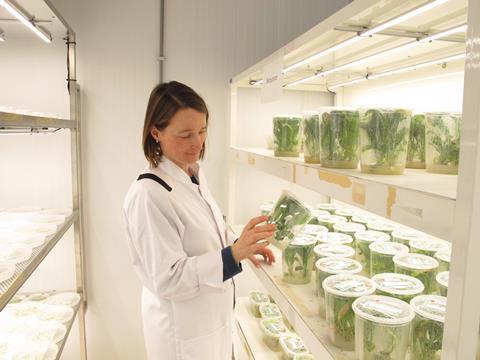Our members form the beating heart of our societies. Here, we regularly highlight one of them. This time, it’s NBV-member Katarina Cankar.
What do you do with chemistry?
‘I am studying the biosynthesis of plant secondary metabolites. Plants make these secondary metabolites to respond to their changing environment and use chemistry as a language to interact with other organisms, including microorganisms and insects. I am interested in pathway discovery and characterization of enzymes that produce plant natural compounds. We can apply this knowledge of pathways in plants to improve resistance or food quality. We are also transferring plant pathways to microbial cell factories to produce plant compounds by fermentation. ’
Why did you specialize in Plant Biochemical Diversity?
‘Plants have developed an immense number of natural products. This wealth of metabolites is not only crucial for the plants’ own survival and growth, but also offers applications for humans in areas such as food, medicine, agriculture, and industry. I find it a truly interesting field, since there are so many different aspects of studying plant metabolites. As a result, I collaborate with scientists from a wide range of disciplines, including plant genomics, phytopathology, as well as industrial microbiology, food science, medical, and social sciences. I really enjoy the collaborations and the diversity of projects.’
‘I believe some of this knowledge may have already been lost’
If you had access to unlimited funding, what research would you conduct?
‘I would conduct further research on the biosynthesis and the bioactivity of medicinal sesquiterpene lactones. A well characterized example is the anti-malarial compound artemisinin. This compound is part of a large class of approximately 5000 terpenes, mainly produced by plants of the Asteraceae family. I would love to work in an interdisciplinary team to study their biosynthesis, the evolution of the enzyme families involved in their biosynthesis, their role within the plant, and their medicinal potential.’

Who would you like to meet, and what would you ask them?
‘I would love to meet traditional healers from the past that had a lot of knowledge about medicinal workings of plants. I believe some of this knowledge may have already been lost. I find it very interesting to learn about traditional uses of plants and combine this with modern research approaches.’
Why do you think it’s important to be a member of the NBV?
‘For me as a plant biologist, the NBV provides a great connection to the field of biocatalysis, synthetic biology and industrial microbiology. This is crucial for me as I am working at the intersection of these fields.’
What do the plants in this photo mean to you?
‘In the photo you can see chicory plants growing in tissue culture. Chicory is an old European medicinal plant and is also used nowadays to produce inulin, a soluble food fiber. As an Asteraceae, chicory also produces bitter medicinal terpenes that are currently discarded. In the recently finished EU CHIC project we obtained chicory varieties that contain higher amounts of anticancer and anti-inflammatory terpenes.’
Katarina Cankar is a senior scientist in Plant Biochemical Diversity at Wageningen University & Research.













Nog geen opmerkingen